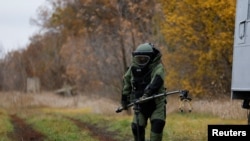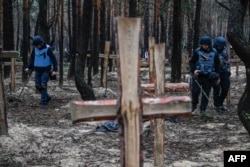On April 13, Russia’s Embassy in Australia called an Australian Broadcasting Corporation (ABC) TV report on the use of landmines in Ukraine “disinformation.”
“On 12 April, ABC News fed its audience with another propaganda story borrowed from BBC. It was about antipersonnel mines killing and maiming hundreds of civilians in Izyum and other parts of the Kharkiv region of Ukraine,” the embassy wrote on Facebook.
It linked the post to a report by New York-based Human Rights Watch that documented the Ukrainian military’s alleged use of antipersonnel mines in and around the city of Izyum when the area was under the control of Russian forces.
“Quite expectedly, ABC News chose to parrot Ukrainian claims that the mines were laid by the Russian forces without mentioning the readily available evidence that the prohibited deadly devices are, in fact, of Ukrainian origin,” the Russian embassy post read.
“Disinformation by omission is routinely practiced by the ABC, contributing to the continued gaslighting of the Australian public.”
That is misleading.
In their reporting on the use of landmines in Ukraine’s eastern Kharkiv region, the BBC and ABC have mentioned the allegations raised by Human Rights Watch in a report published on January 31.
But the January 31 Human Rights Watch report was largely focused on the city of Izyum and the surrounding area, while the reports criticized by the Russian embassy covered the entire Kharkiv region.
In the January 31 report, Human Rights Watch outlined what it called the Ukrainian military’s “apparent use of thousands of rocket-fired antipersonnel landmines in and around the eastern city of Izyum,” located in Ukraine’s Kharkiv region, and called on Ukraine to investigate those findings.
By contrast, the BBC report, published on April 11, described the use of landmines across the entire Kharkiv region and other parts of Ukraine, “an area of land larger than England, Wales and Northern Ireland combined.”
The BBC reported that Russia had “seized swathes of territory in the Kharkiv region,” only to be “blindsided by a Ukrainian counteroffensive” in May 2022.
"The Russians deployed landmines to both defend their positions and slow the Ukrainians. After leaving in a rush, a lethal footprint was left behind,” the BBC report stated, noting that “[m]ore than 55,000 explosives have been found in the area.”
A screenshot of the ABC television report shared by the Russian embassy has a caption that reads: “Deadly landmines in Kharkiv region are killing hundreds.”
A separate ABC News report, published on March 19, cited the Human Rights Watch report about Ukraine’s alleged use of mines in Izyum and Russia’s use of mines across eastern Ukraine.
ABC News reported:
“Human Rights Watch has documented that Moscow has used at least eight types of anti-personnel mines, prohibited by the Geneva Conventions, throughout eastern Ukraine.
“In a January report, the rights monitor also called on Kyiv to investigate the Ukrainian military's apparent use of thousands of banned petal mines in Izyum."
The April 11 BBC article also directly addressed the HRW report and the use of landmines in Izyum.
The Human Rights Watch Report cited by Russia’s Embassy in Australia also said Russian forces “have used antipersonnel mines in multiple areas across Ukraine,” including “victim-activated booby traps.”
Human Rights Watch said it had “previously published three reports documenting Russian forces’ use of antipersonnel landmines in Ukraine in 2022.”
One of those three reports was about Russia’s use of “banned antipersonnel mines in the eastern Kharkiv region” that "were apparently delivered by rockets fired from specially designed ground launchers.”
The BBC report was somewhat ambiguous about Izyum and the use of rocket-fired anti-personnel PFM mines, also known as butterfly mines or petal mines.
The BBC described PFM mines as “the most common in the area,” presumably the Kharkiv region. It did not specify who deployed them.
In August 2022, the U.K. Defense Ministry accused Russia of deploying butterfly mines in Ukraine’s Donetsk region, noting they “were used to devastating effect in the Soviet-Afghan War.”
But in its report on Izyum, Human Rights Watch said it had documented Russia’s use of other antipersonnel mines in Ukraine, “but has not verified claims of Russian forces using PFM mines in the armed conflict.”
The BBC also addressed Human Rights Watch’s allegations against Ukraine, writing:
“Izyum and its surrounding area is one of the most heavily mined places, yet the picture in the city is murky.
“Human Rights Watch has accused Ukraine of using illegal antipersonnel mines here. Kyiv responded by saying it followed international law while defending itself.
“The organization has previously accused Russia of using similar devices across Ukraine during its full-scale invasion.”
After Human Rights Watch published its report on January 31, Ukraine’s Foreign Ministry said it would look into the allegations its forces had used banned anti-personnel mines.
The ministry claimed Ukraine “fully implements its international obligations while Russian occupants commit the war crimes, crimes against humanity and genocide of the Ukrainian people.”






